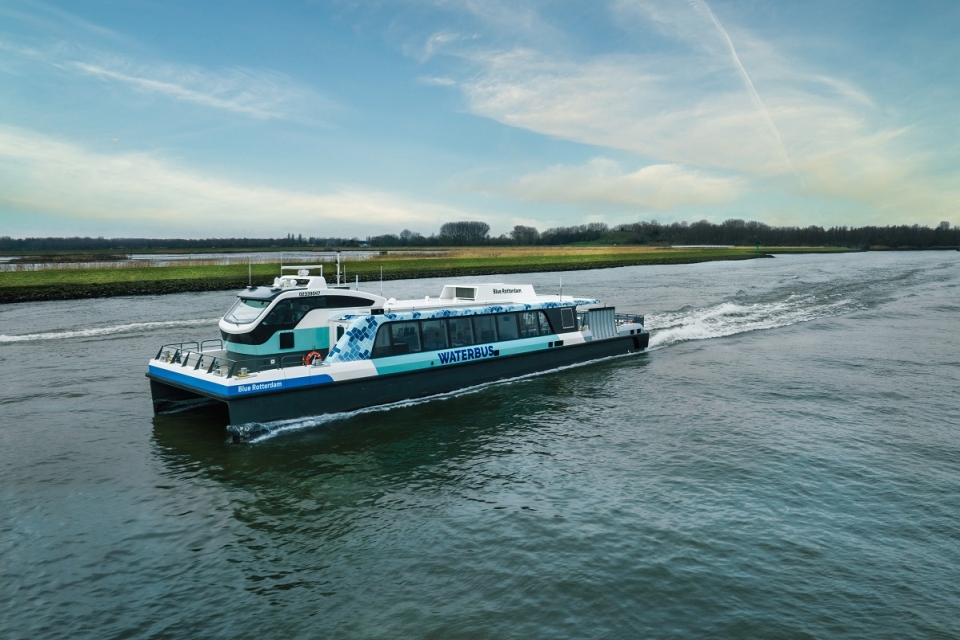The Damen Waterbus 2907 E3 has received a Dutch Design Award (G100). The G100 represents the top 100 product designs in the Netherlands. Nominated solutions are judged by a panel of industrial design experts.
Awards are given to products and solutions that are relevant, innovative and/or original, and exceptionally well designed in the Netherlands by a Dutch designer or for a Dutch company and have been introduced into the market within the last two years.
The Waterbus 2907 E3 is designed by Damen Shipyards Group and KesselsGranger for operation in the Dordrecht-Rotterdam area as part of the Waterbus service. The design pays close attention to both passenger experience and sustainability.
‘The design of the vessel began with the vision of Gerbrand (Schutten, CEO and Founder of Waterbus),’ explains Jan van Ooijen, design and proposal engineer public transport at Damen. ‘He has a clear idea of the type of service he wants to offer. This is a service with high levels of sustainability and that embraces the diverse types of passenger that will use it, be they commuters, tourists, groups, people with impaired mobility, etc. All these passengers have different requirements and how those are incorporated into this design is the essence of the Waterbus story.’
Also read: First all-electric ‘waterbus’ for Dutch Drechtsteden christened
Incorporating inclusion
Examples of this suitability to such a wide audience are plentiful throughout the vessel. This includes, for example, a large space aft, suited to tourists who would like a place from which to observe the sites along the route.
For those using the Waterbus on their daily commute, comfortable working spaces are offered in the interior section of the vessel. Additionally, the ample space for storage of bicycles has been well thought out. Bicycles are placed on the vessel according to the destination of the passenger, making their retrieval quick, straightforward and efficient upon arrival.
Seating has also been laid out to accommodate groups of people. This includes a lounge bench seating area in the middle of the vessel. The bench features recesses to accommodate children’s pushchairs and prams, as well as wheelchairs. The Waterbus is one of the first ferries to feature tactile strips on the floor to help guide blind and partially sighted passengers. Mobility through the vessel is similarly aided by high contrast floor markings and clearly delineated zones.
To enhance the onboard experience, the designers have aimed to create a warm, open and safe feeling environment. This includes use of large windows along the length of the vessel, and in the ceiling, allowing ample light and providing a feeling of spaciousness.
Also read: Damen to build 9 ‘waterbuses’ for Rotterdam area
Ready for fully electric
Sustainability is a theme that runs throughout the Waterbus design. The vessel features Damen’s E3 logo representing economy, environment and efficiency. Its lightweight, carbon-fibre design and hybrid propulsion system ensure that emissions and noise are kept to an absolute minimum. The vessel is also prepared for a greener future, with the option to switch to full electric operations when the time arrives.
The interior of the Waterbus draws on materials that are locally produced, recycled or upcycled and totally circular. An example of this are the carpets, which are made from local fishing nets that have been reclaimed from the sea.
The passenger seating, meanwhile, is wooden and delivered by a local company committed to its reuse at the end of life. The seating is covered with material made of high wool content and therefore featuring the self-cleaning properties of lanolin.
Dutch Design Week
The Waterbus will be presented, along with other award winners, during the Dutch Design Week in Eindhoven, the Netherlands, from the last week of October. At the stand, visitors will be able to view a detailed scale model of the vessel and to watch a video showing the Waterbus in action and featuring interviews with representatives from Waterbus, Damen and KesselsGranger. A poster will explain the thinking behind the design and show the ways in which the vessel has been able to achieve its goals.
Also read: Waterbuses ordered for public transport in Antwerp








